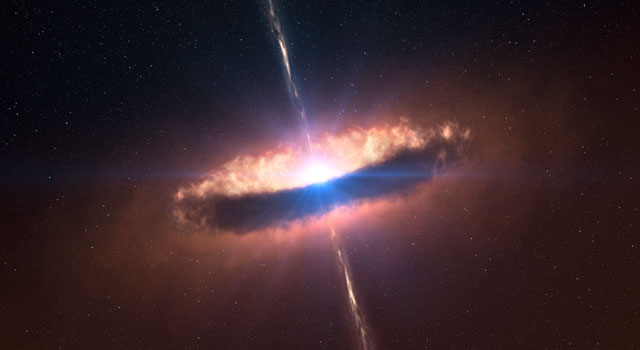A new discovery of a disk of gas and dust surrounding a young giant star has the potential to answer an age-old question about how massive stars are born and hint at the possibility that planets can form around the galaxy's largest bodies

A new discovery of a disk of gas and dust surrounding a young giant star has the potential to answer an age-old question about how massive stars are born and hint at the possibility that planets can form around the largest bodies in the galaxy.
"Until now, astronomers have not clearly known how massive stars were formed," says Steven Krauss, a NASA Sagan Fellow and an astronomer at the University of Michigan in Ann Harbor. "Because they tended to be at great distances and surrounded by envelopes of dust, it was very difficult to separate them and observe them closely."
To observe them better, Kraus' team used the Very Large Telescope interferometer at the European Southern Observatory in Chile to observe the star IRAS 13481-6124, which is about ten thousand light-years distant from us in the direction of the Centaurus group, and is 20 times more massive than the Sun. "We were able to get a sharp view of the innermost regions around the star using a combination of light-separating telescopes," Kraus said. "In general, it can be said that we imitated the resolving power of a telescope with a mirror with an incredible diameter of 85 meters."
The observation produced a fortunate result: the discovery of a massive disk of gas and dust surrounding the young giant star. "This is the first time something like this has been observed," Kraus said. "The disc is very similar to what we see around much smaller young stars, except that everything is on a more massive scale."
The presence of the disk is new evidence that even the largest stars in the galaxy are formed in the same process as the smaller ones - they grow by collecting huge amounts of gas and dust and not by merging smaller stars as previously suggested by several scientists. The result was confirmed by NASA's Spitzer Space Telescope. "We looked at archival photographs of the star taken by Spitzer and confirmed the existence of a disk-shaped material facing outward from the polar region of the star, just as we see in smaller stars and their disks." Krauss said.
The discovery also opens up the possibility that planets, perhaps even ones similar to Earth, may form around a massive star such as IRAS 13481-6124, in the same way that they formed around our Sun when it was much younger. "In the future we will be able to see gaps in this disc and others that will be created by planets orbiting these young suns, but it is unlikely that such bodies will survive for a long time," Kraus said. "A planet orbiting such a massive star will be destroyed by the strong solar wind and enormous radiation as soon as the rest of the disk protecting it disappears, and therefore the system will have a low chance of developing into a solar system like ours."
Still, massive stars such as IRAS 13481-6124 provide the building blocks for life elsewhere in the universe. "Massive stars are the place where the elements heavier than iron are formed, which are essential for life and hence their great importance. "This discovery provides us with a clearer picture than we have had so far and will allow us to understand them better."
The Spitzer Space Telescope has previously discovered planetary debris disks around more mature massive stars, which supports the notion that planets may also form in such extreme environments.
More about the research on the Spitzer Space Telescope website

6 תגובות
Today is the 41st anniversary of the moon landing
Nimrod - I said the things with humor - I do not blame you (:
deer,
I really don't blame the science site, I saw the original article, everything that was done here was a translation.
I would have reacted in exactly the same way to the original article, and I am also quite happy that this article was brought here, because I have not seen it on other science websites in the world and the article is indeed important.
Nimrod,
As for the doubt - you have nothing to blame the site of the scientist (but the scientist), I guess they are probably citing the original article in which the discovery was reported. Either way, you have nothing to worry about - no one is going to accept a theory about the formation of stars because of one gas disk - if the theory is abandoned, it is because of many spot discoveries and many theoretical conclusions.
A little semantics (and a little doubt):
"The presence of the disc is new evidence that even the largest stars in the galaxy are formed in the same process as the smaller ones - they grow through the collection of huge amounts of gas and dust and not through mergers of smaller stars as previously suggested by several scientists. The result was confirmed by NASA's Spitzer Space Telescope.
It is said that these stars grow by collecting gas and dust and not by merging smaller stars, the mere development of a massive star is a stellar struggle does not determine that all supermassive stars are formed in this process (although this discovery sheds light on the process) it may still be that some of the supermassive stars Massive ones are formed by merging two smaller balls.
I don't understand... can be both and not?
Both formed from smaller stars with the help of fusion and from "dust".
Although I guess that those formed from smaller stars should be relatively new to their environment and should be in a place where there are relatively many stars.
Whereas, as is the way of nature, most of the time there is a struggle.